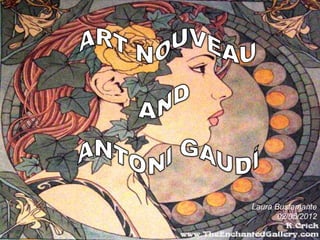
Art Nouveau and Antoni Gaudi
- 1. Laura Bustamante 02/05/2012
- 2. INDEX
- 4. INTRODUCTION TO THE ART NOUVEAU Art nouveau is an artistic movement that started at the end of the 19th century and developed in the first decades of the 20th century. It is a decorative style, in which we can find: curved lines, organic motifs, exuberant decoration… Art nouveau artists tried to create a new young and free art. Also they drew inspiration from nature.
- 5. CHARACTERISTICS The characteristics are: Inspiration on Nature and the use of elements of natural origin and with some preference for plants. Use of feminine images in delicate and graceful attitudes, with generous utilization of the waves in the hairs and the folds in the clothes. Attitude tending to sensuality and senses, arriving, in some cases, to the eroticism.
- 6. PRINCIPAL USES OF ART NOUVEAU GRAPHIC ARTS In graphic arts, illustration of books, magazines and in the advertising posters and also in all kinds of supports, as postcards, patterned, etc... PAINTING ARTS Art Nouveau painting emphasized the erotic representation of woman, in some cases close to the perversion. Technically painters insisted on the clarity of the line, and the expressiveness of the drawing. They also used organic forms, with curved lines and spirals. The Most Important painters are: Santiago Rusiñol, Ramon Casas, Antoni Utrillo, Henry Edward Potthast, Albert Edelfelt. SCULPTURE Woman was the principal theme in sculpture and she was represented in different attitudes. Some important sculptures are: Paul Aichele, Denis Foyatier, Eugène Désiré, Victor Prouvé, Ernest
- 7. GRAPHIC ARTS: Advertisin g posters PAINTING by: Henry Edward Potthast PAINTING by: Albert Edelfelt SCULPTU RE by: Denis Foyatier
- 8. PAINTIN G by: Santiago Rusiñol SCULPTU RE by: Paul Aichele PAINTIN G by: Ramón Casas
- 9. IMPORTANT CENTRES OF THIS STYLE Brussels, Paris and Barcelona were the most important centres of this style. In Paris Hector Guimard designed several metro station entrances. For example: Palais Royal- Musée du Louvre, Réaumur-Sébastopol, Tuileries, Roszé Hotel, Castel Béranger,Guimard Hotel … In Brussels Victor Horta built the Hôtel Tassel and his house. More examples: House Matyn, Hôtel Winssinger, Palais des Beaux-Arts of Bruxels … In Barcelona The most important architects were Lluís Domènech I Montaner and Antoni Gaudí. some Lluís Domènech´s most important works are: San Pablo’s Hospital, Palace of Catalan Music, The Castle of three dragoons… And some of Gaudi´s most important works are: Belles Guard, Batlló House, The Holy Family…
- 10. Hector Guimard’s: the metro station entrance Palais Royal- Musée du Louvre: Victor Horta’s Antoni Gaudí’s: Palais des Beaux-Arts of Batlló House Bruxels
- 11. LLUÍS DOMÊCNECH I MONTANER MUSIC PALACE HECTOR GUIMARD’ S METRO STATION VICOR HORTA’ S HÔTEL TASSEL
- 13. INTRODUCTION TO ANTONI GAUDÍ Gaudí was the most important representative of Art Nouveau in Spain. He was very influenced by Gothic art and oriental styles. He drew inspiration from different natural landscapes for example: Valley of The Chimneys of the Fairies, the Cave of the Salnitre in Collbató and Montserrat's mountain and found original solutions for the buildings he designed. Many of his works were commissioned by the Güell family. For example: Palau Güell, Park Güell, Güell Pavilions in Pedralbes, Güell Estate, The Palace Güell, Cologne Güell ….
- 14. PLACES FROM WHICH GAUDÍ TOOK INSPIRATION Valley of The Chimneys of the Fairies The Cave of the Salnitre in Collbató Montserrat's mountain
- 15. WORKS COMMISSIONED BY THE GÜELL FAMILY. PARK Güell GÜELL Pavilion s GÜELL PALAC E
- 16. WORKS His works stand out for the great precision of the details, and for the use of geometry. When he obtained the architect degree in 1878 his first works were some streetlights for the Royal Plaza, the project of Girossi Kiosks and another project for the “The Working Mataronense "Cooperative. This was his first important work. The streetlights were inaugurated in the celebrations of the Mercè, of 1879.
- 17. HIS FIRST WORKS IN IMAGES Girossi Kiosks The Working Streetlights Mataronense for the Royal "Cooperative Plaza
- 18. THE HOLY FAMILY His most important work was The Holy Family, located in Barcelona. It is a great Catholic Basilica. Its construction started in 1882, but Gaudí took the project in 1883. Nowadays, it is still under construction. When the basilica will be finished, it will have 18 towers: 12 dedicated to the apostles, 4 to the Evangelists and another one, dedicated to Maria and other one to Jesus. Each of them will have different height, depending on the order that they occupy in the hierarchy.
- 19. THE HOLY FAMILY When Gaudí started directing the construction of the temple, only the crypt was built. He decided to change the style, for another one inspired in plants. Gaudí evolved from the first Neogothic project towards his particular naturalistic style adapted to the nature; Gaudí thought that Gothic style was imperfect, because its straight forms, its system of props and buttresses didn´t reflect the laws of (the) nature. Gaudí only built the facade of the Birth and the crypt, because he died in 1926 and only these two parts and a tower had been built at that moment.
- 22. BARCELONA’S STREETLIGHTS Another of his important works was Barcelona’s Streetlights. Gaudí received the order to design some streetlights for the Town Hall of Barcelona. For this order he prepared two different types of streetlights: one of six arms, which was established in the Royal Square, and another one of three arms, which also was established in the square of Palace, opposite to the civil government. The streetlights were made of cast iron, with marble base, in which it is possible to observe the shield of Barcelona
- 24. CREDITS: BLANCO, Cristina and PÉREZ, Paqui, Social Sciences History, 4º Year ESO Images: Google images http://www.flickr.com/photos/scrabble2/5469247442/l ightbox/ Wikipedia images Webs: Wikipedia: es.wikipedia.org/ http://www.gaudisagradafamilia.com/lesser-known- gaudi-works/gaudis-streetlights.html